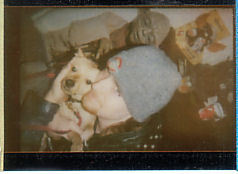How do blind people figure what kind of dollar they're being handling? After all, aren't $1 and a $20 bills all the same size? You may be surprised to know that every major currency issuer in the developed world has found a way to solve this problem—except the US. (1/5)
In the United Kingdom, like in many countries, bills vary in length, with higher bills naturally being longer. It's probably slightly too subtle for most people to notice, but it's immediately obvious to a blind person who knows what to look for. (2/5)
Many other currencies, like the Euro, combine length variation with intaglio printing—essentially, raised numbers that you can easily feel. Again, too subtle for most people, but a lifeline for the blind. (3/5)
@mnolangray This is sort of true about the UK. However it's actually really difficult to tell just by holding it, unless you can compare it to something else. Our notes now have tactile markings though.
@mnolangray I can't speak for the pound, but the colourful notes on the left are Australian
@mnolangray Was this meant with irony "immediately obvious to a blind person who knows what to look for" 😎
@mnolangray Those notes (the ones in the background, showing the size difference) are Australian dollars, not UK pounds
@mnolangray Dont forget the little textile bumps in the clear forgery prevention windows
@mnolangray Pretty sure those are Australia’s banknotes in 2.
@mnolangray Australian notes (left) also have Braille on them so that blind people can feel what note they are handling Also, the vastly different colours make it so much easier to tell what note you're searching for at a glance
@mnolangray FYI the notes on the left are Australian, not from the UK at all. This image is probably a comparison between the Australian and UK designs.
@mnolangray @ninefoldrin2 American money sucks
@mnolangray @PGH_by_Eppu I actually did know that, and it infuriates me that the US doesn't bother with such common sense measures to help blind people.
@mnolangray We've also changed our notes in Australia over the past couple of years, I believe part of that is for easier differentiation as well that the bumps (1-5) are a feature of the new ones that weren't there previously, the numbers are more legible for vision impaired as well.
@mnolangray The megabig and no-longer-printed 500 Euro notes
@mnolangray Why would the Federal Reserve ignore an opportunity to simply vary the length of paper currency, when they are printing furiously? #disabilities wsj.com/articles/bank-…
@mnolangray Don’t know how to trust anything people say on twitter when they literally show the wrong country’s currency….
@mnolangray Just for clarity the notes on the left are Australian.
@mnolangray Also, there are raised dots on newer notes. £10 has two squares in the top left corner, and £20 has three squares and £50 has four squares. £5 has none on the note I just checked.
@mnolangray Those bills on the left are Australian
@mnolangray The UK also presses Braille in the corner
@mnolangray I didn’t even know that, I’ve always thought they were the same length. Also where did that £100 note come from? 😅
@mnolangray FYI: Mexican Peso's are also all different sizes just like the UK.
@mnolangray Should be noted UK bank notes also have dots in the corner (similar to Braille but not quite conforming to any letters) to make them identifiable to touch. sightadvicefaq.org.uk/money-benefits…


























